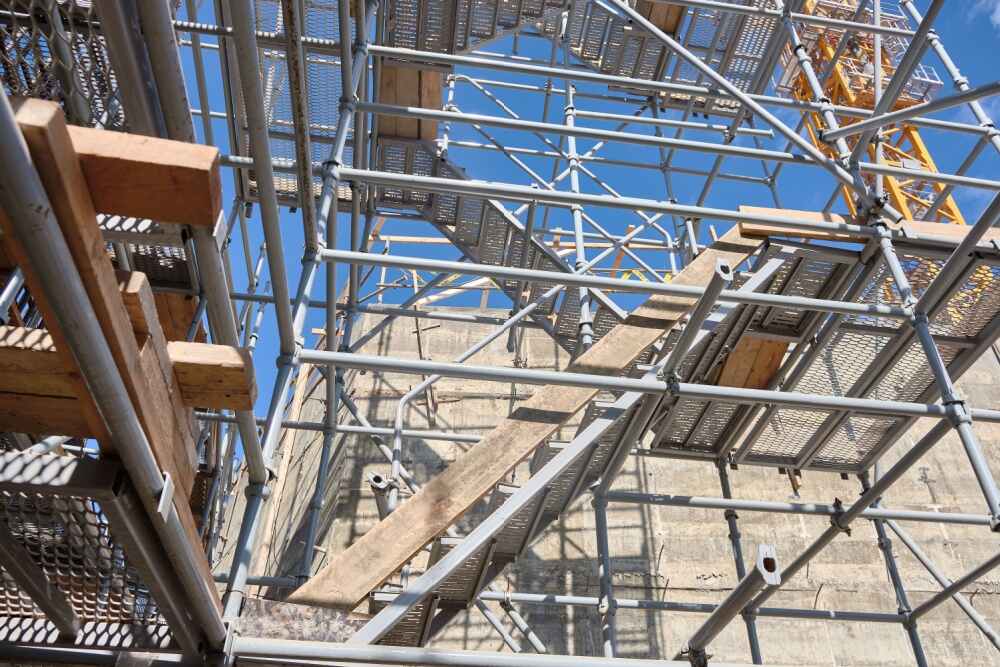How Much Does a Scaffold Cost? Key Influencing Factors
Scaffolding is essential for safe and efficient construction projects. If you’re a contractor or project manager, knowing how much scaffold costs is key to budgeting well. Many factors affect the scaffolding price. It’s important to understand them before choosing to rent or buy.
Factors That Affect Scaffolding Costs
The cost of scaffolding can vary widely. Key factors include the material, project height, complexity, and duration. Each factor impacts the total scaffolding cost and should be considered early in the planning process.
Type of Scaffolding Material
The material you choose affects the overall price of scaffolding. Steel is strong and great for heavy-duty jobs, but it costs more. Aluminum is lighter, easier to move, and better for smaller tasks or short-term projects. Wooden scaffolding is another option, but it’s less durable than metal.
New scaffolding is reliable but more expensive. Used scaffolding can save money but be sure to inspect it carefully for safety and condition. Balancing cost and quality is key to keeping safety intact.
For larger projects, using a mix of materials can save money. Steel gives strong support, while aluminum is better for easy-to-reach areas. This helps manage costs without sacrificing safety or efficiency.
Height and Challenge of the Structure
Height has a big impact on scaffolding costs. Taller buildings need more materials and safety features, which raise expenses. Unusual shapes or detailed designs may require custom scaffolding, increasing costs.
Projects with historical buildings or delicate designs often need specialized scaffolding. These systems involve custom designs, which add to the cost. Planning ahead can help avoid surprises later.
For multi-story projects, modular scaffolding can be a cost-effective solution. These systems are flexible, allowing adjustments as the project moves forward. They can also reduce setup time, which helps lower labor costs.
Project Duration
Rental costs are usually charged daily, weekly, or monthly. Longer rentals generally cost more, so it’s important to estimate your timeline as accurately as possible. Delays can quickly add to your overall expenses.
To save money, try negotiating discounts for longer rentals. Being flexible with your schedule can also help you avoid unexpected fees and additional costs.
If your project timeline is uncertain, consider exploring hybrid options. Some companies offer rent-to-own programs, where rental fees can be applied toward a future purchase. This can be a smart and cost-effective choice for long-term or extended projects.
Renting Versus Buying Scaffolding
When budgeting for scaffolding, you’ll need to decide whether to rent or buy. Each option has pros and cons.
Renting Scaffolding
Renting is a good choice for short-term projects. The average price of scaffolding hire is $950 per week in the United States. Renting avoids large upfront costs, but long-term projects can become expensive. The average cost of scaffolding will vary based on these factors.
Renting also gives you access to newer scaffolding models without committing to ownership. If a project requires a specific type of scaffolding, renting provides flexibility. However, frequent rentals can cost more than buying over time, as the total average price of scaffolding is $3,000.

Buying Scaffolding
Buying scaffolding is a long-term investment. It eliminates ongoing rental fees and allows reuse on future projects. The upfront cost can be high, especially for quality materials and large quantities.
Still, it’s worth considering. For contractors with many projects, buying may be more cost-effective.
Ownership also means you’re responsible for maintenance. Regular inspections and proper storage are essential to keep scaffolding in good condition. Neglecting these can lead to safety risks and unexpected repair costs.
Buying also allows for changes. If you often work on unique projects, owning scaffolding lets you customize it. This can improve efficiency and safety while reducing downtime.
Hidden Costs to Consider
In addition to rental or purchase prices, there are hidden costs to consider. These can significantly impact your budget if overlooked.
Delivery and Setup Costs
Transporting scaffolding to and from the site often adds extra fees. Assembly and disassembly costs depend on how complex the setup is. Whether you hire a scaffolding provider or use your team, be sure to include these costs in your budget.
Proper setup needs skilled workers to meet safety standards. Hiring experienced workers may cost more but ensures the job is done safely. Some providers include setup in their service package, which can simplify the process.
If your project is in a remote location, be prepared for extra transportation costs. Planning deliveries during off-peak times can help lower fees, especially in busy areas.
Permit and Regulatory Fees
Some projects require permits for scaffolding, especially in urban or regulated areas. Permit fees may seem small, but they can add up for larger projects. Ignoring permit requirements can result in fines or delays.
Research local regulations early and include permit fees in your budget. This helps ensure compliance and avoids costly disruptions.
Regional Differences in Scaffolding Costs
Location also affects scaffolding prices. Labor rates, material availability, and local regulations vary between regions.
Urban Versus Rural Areas
The scaffolding cost is often higher in urban areas. Cities need more complex designs for space and safety rules, which raise costs. Rural areas may cost less but have higher transportation fees if materials are far away.
Local Economy and Demand
The local economy and construction demand influence prices too. Busy construction markets often have higher costs due to increased demand. In quieter regions, prices may be lower for similar materials and services.
During peak construction seasons, prices can spike. Planning projects during slower times can help you get better rates from suppliers and contractors.
Calculating Scaffolding Costs
Understanding scaffold costs helps you plan more effectively. The price depends on factors like material, height, and rental duration. Don’t overlook extra costs such as delivery and permits. Whether renting or buying, considering the pros and cons can save time and money.
By knowing these cost factors, contractors and project managers can make smarter decisions. Good planning keeps projects on track and within budget, while focusing on safety. Prepare for every detail to ensure smoother operations and better results. Check out our scaffolding selection!
